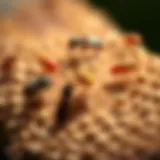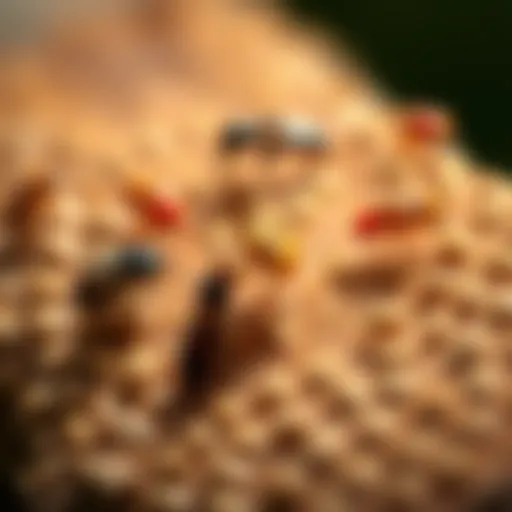Explore Larue Pest Control: Strategies and Innovations


Intro
Pest control is an essential aspect of maintaining a healthy and safe environment in our homes. Larue Pest Control stands out in this field, employing various approaches to safeguard residences from pests. Understanding pest identification, prevention methods, and effective DIY solutions are crucial for homeowners. This article aims to provide insights into these areas, focusing on the effective practices that Larue Pest Control implements.
Pest Identification
Proper pest identification is the foundation of successful pest management. Knowing what type of pests invade your home can lead to effective control strategies.
Common Household Pests
Some of the most common pests found in households include:
- Ants: Often found in kitchens, attracted to food sources.
- Roaches: Thrive in warm, moist areas, posing health risks.
- Termites: Cause structural damage by feeding on wood.
- Bed Bugs: Hide in bedding and upholstery, making eradication tricky.
- Rodents: Like mice and rats can contaminate food and spread disease.
Each of these pests exhibits unique behaviors and preferences. Identifying them accurately allows for tailored solutions.
Signs of Infestation
Recognizing the signs of pest infestations prompts timely action. Some indicators to watch for include:
- Droppings: The presence of droppings in hidden areas often signals infestation.
- Nesting: Look for nesting materials, such as shredded paper or fabric.
- Gnaw Marks: Rodents leave distinct gnaw marks on food packages or wood.
- Signs of Damage: Look for chewed wires or wood, indicating a problem.
"An early detection is key to effective pest control. The sooner an infestation is identified, the easier it is to manage."
Prevention Methods
Preventing pests before they invade should be a priority for every homeowner. Implementing certain strategies can minimize risks substantially.
Environmental Modifications
Modifying the environment can help deter pests. Recommended changes include:
- Sealing Cracks: Ensure windows and doors are properly sealed to prevent entry.
- Proper Drainage: Eliminate standing water, which attracts various pests.
- Landscaping: Maintain vegetation away from the home's foundation to reduce hiding spots.
Home Maintenance Tips
Regular maintenance of the home plays a vital role in pest prevention. Consider these tips:
- Regular Cleaning: Keep the home clean to eliminate food sources.
- Food Storage: Store food in airtight containers to prevent attracting pests.
- Inspection: Regularly check for signs of pests and address faults promptly.
DIY Pest Control Solutions
For those interested in taking action themselves, various DIY pest control solutions exist.
Natural Remedies
Several natural remedies can help with pest control, such as:
- Essential Oils: Oils like peppermint or tea tree can deter many pests.
- Diatomaceous Earth: A natural powder can kill insects when dusted in infested areas.
- Vinegar and Water: A mixture can clean surfaces while repelling ants and other pests.
DIY Traps and Barriers
Creating your traps can be both effective and cost-efficient. Examples include:
- Homemade Ant Traps: Use sugar and borax to draw and kill ants.
- Mouse Traps: Simple snap traps can be made using common household items.
- Natural Barriers: Planting specific herbs can repel pests naturally, like basil and lavender.
Understanding pest control is crucial for every homeowner. Larue Pest Control offers comprehensive approaches, but knowledge of basic strategies empowers individuals. With the right identification, prevention, and DIY solutions, managing pests becomes an achievable goal.
Foreword to Larue Pest Control
Understanding the role of Larue Pest Control is crucial for homeowners and pest management professionals alike. As a significant player in the pest control sector, Larue offers a blend of traditional and innovative strategies. This provides valuable insight into its effective practices.
Focusing on their methodologies and techniques can help homeowners make informed decisions regarding pest management. It highlights the importance of addressing pest control not just as a reactive measure but as a proactive process. This awareness leads to a safer and healthier living environment.
Overview of Pest Control Industry
The pest control industry operates within a complex framework of environmental and societal concerns. It addresses the need for safeguarding homes and businesses against various infestations. Pests like rodents and insects can pose health risks and damage property. Thus, effective pest management is essential.
The industry has evolved over years, with increasing emphasis on sustainability and eco-friendly solutions. Many companies now incorporate Integrated Pest Management (IPM) approaches, focusing on long-term prevention. This shift aims to balance efficacy with minimal environmental impact, attracting homeowners to choose responsible pest control options.
History and Evolution of Larue Pest Control
Larue Pest Control has a rich history that reflects the broader trends in pest management. Founded decades ago, it began as a local service providing basic solutions to common infestations. Over the years, Larue adapted to changes in consumer expectations and regulatory environments.
Innovation has been key in its evolution. Recognizing the rising demand for eco-friendly practices, Larue invested in research and development. This focus resulted in the integration of biodegradable products and non-toxic methods into their service offerings. The company now stands out for its commitment to both customer satisfaction and environmental sustainability.
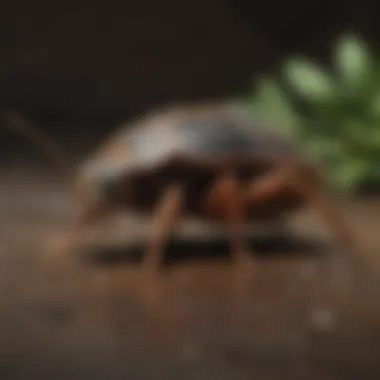

Through this exploration, we will uncover how Larue Pest Control not only deals with pest problems but also contributes to the broader narrative of responsible pest management.
Pest Identification Techniques
Pest identification is critical within the realm of pest management. Understanding which pests invade a space and their behaviors can significantly influence the approach taken to address them. The benefits of accurate identification are numerous, including the ability to apply targeted treatments and the necessity to recognize potential health risks associated with specific pests. It is essential for homeowners to familiarize themselves with typical signs of infestation. This not only enables timely intervention but also helps in understanding the biology of the pests involved, leading to more effective control strategies.
Common Pest Types
Rodents
Rodents, such as mice and rats, are among the most common pests people encounter. Their ability to reproduce quickly makes them a significant concern for homeowners and businesses alike. They not only damage property but can also pose serious health risks through diseases they carry. A key characteristic of rodents is their sharp incisors, which continuously grow. This necessitates gnawing on materials to wear down their teeth. Thus, they are known for causing damage to wiring, insulation, and even food supplies. Their high adaptability to various environments makes them a focus in pest management discussions.
The presence of rodents is easily identifiable through signs like droppings, gnaw marks, and nests. This makes them a popular inclusion in studies focused on urban pest control. However, their numbers and behaviors can make them difficult to manage once established. Effective control measures are necessary to mitigate their impact on residential spaces.
Insects
Insects form a vast and diverse group of pests. Some of the most problematic insects include ants, cockroaches, and termites. Each species brings its own set of challenges to pest management. For example, termites can cause severe structural damage to homes. Therefore, understanding their biology is crucial for effective control.
Insects generally have a high reproductive rate and some species can develop resistance to certain pesticides over time, making them a challenging aspect of pest control strategies. A key feature of insects is their exoskeleton, which protects them from many conventional methods of control. Their adaptability to different environments further complicates eradication efforts. Awareness of common insects and their behavior strengthens homeowners' ability to detect and address infestations early on, facilitating better pest management.
Wildlife
Wildlife incidents, while less frequent than other pest types, can cause significant issues for homeowners. Animals such as raccoons, squirrels, and skunks often seek shelter in attics or basements. This behavior can lead to property damage and increased risks of disease transmission. A significant characteristic of wildlife is their natural instincts, which drive them towards human habitats in search of food and shelter.
The unique feature of wildlife pests includes their unpredictable behavior. Unlike insects or rodents, wildlife tends to be more difficult to trap and exclude. Their presence often requires specialized management approaches, including the assessment of entry points and exclusion tactics. Education about these wildlife types is essential for homeowners to mitigate risks effectively, ensuring that their living spaces remain safe and uncontaminated.
Signs of Infestation
Identifying signs of infestation is a requisite skill for effective pest control. Common indicators may include:
- Visible droppings or urine stains
- Gnaw marks on furniture and walls
- Nesting materials, such as shredded paper or insulation
- Noises from walls or attics, especially at night
Recognizing these signs early plays a crucial role in preventing a minor pest issue from escalating into a full-blown infestation.
Effective pest management begins with knowledge of these types and their signs. Each homeowner must remain vigilant to ensure their home is pest-free.
Methods Employed by Larue Pest Control
The methods used by Larue Pest Control play a crucial role in the effectiveness of their pest management strategies. By integrating traditional and innovative approaches, they can address diverse pest problems efficiently. Understanding these techniques helps homeowners grasp the scope of pest control options available to them.
Traditional Pest Control Approaches
Pesticides
Pesticides are chemical solutions specifically designed to target various pests. In the context of pest management, they serve as a fundamental tool for controlling infestations. Their key characteristic lies in their active ingredients, which harm or eliminate unwanted pests effectively. Pesticides are a popular choice mainly due to their high efficacy in reducing pest populations quickly.
However, there are notable advantages and disadvantages to consider. The advantages include rapid action against pests and the ability to cover large areas effectively. On the downside, the risks include potential harm to beneficial insects and concerns about chemical exposure for pets and humans. Thus, when using pesticides, it��’s crucial to follow safety guidelines and choose formulations appropriate for residential use.
Traps
Traps represent another traditional method employed in pest control. They function based on attracting pests and capturing them without the use of chemical treatments. The unique feature of traps is their variety, from simple sticky traps to more sophisticated baited devices. This method is increasingly favored for its minimal environmental impact and straightforward applicability in homes.
Although traps can be quite effective, some limitations exist. They require constant monitoring and may not address larger infestations immediately. Nevertheless, traps provide an excellent option for those looking to control pest populations while reducing reliance on chemical treatments.
Innovative Techniques
Biological Control
Biological control refers to the use of natural predators or parasites to manage pest populations. This approach is increasingly gaining traction due to its eco-friendly nature. The key characteristic of biological control is its reliance on ecological relationships, making it a sustainable choice for pest management.
The advantages of biological control include reduced chemical usage and long-term pest management solutions. However, the challenges lie in the time it takes for natural populations to establish and the need for careful monitoring to avoid unintended consequences in the ecosystem. Despite these challenges, its growing importance in pest control aligns well with longer-term sustainability goals.
Exclusion Methods
Exclusion methods focus on preventing pests from entering homes and buildings. This technique is grounded in the idea that if pests cannot gain access, the infestation will not occur at all. The key characteristic of exclusion methods is their proactive nature, which emphasizes sealing entry points and maintaining cleanliness.
One significant advantage of exclusion methods is that they reduce the need for ongoing chemical treatments once established. However, homeowners must invest time and effort into thorough inspections and maintenance to ensure these barriers remain effective. Overall, exclusion methods represent a valuable strategy in the toolbox of pest control practices, particularly for those seeking to maintain a pest-free environment long-term.
"Integrated pest management combines various methods to ensure effectiveness while minimizing risk to the environment."
In summary, the choice of methods employed by Larue Pest Control reflects both traditional and modern practices that cater to various pest management needs. Each method carries unique strengths and considerations that homeowners must understand to make informed decisions about pest control.
Eco-Friendly Practices in Pest Management
Eco-friendly practices in pest management are essential to ensure the longevity of ecosystems while addressing pest issues effectively. This approach minimizes harm to the environment, human health, and non-target organisms. The increasing recognition of the ecological impact of traditional pest control methods has prompted a shift towards more sustainable practices. For homeowners, understanding eco-friendly pest management can lead not only to a safer living environment but also to less reliance on harmful chemicals.
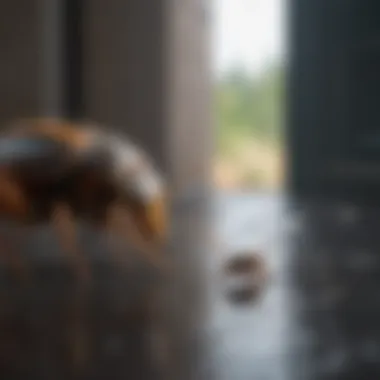

Importance of Sustainability
Sustainability is a critical component of modern pest management. Implementing sustainable practices contributes to a healthier environment. Here are some reasons why sustainability matters:
- Healthier Ecosystems: Sustainable methods protect beneficial insects and other wildlife, enhancing biodiversity.
- Reduced Chemical Use: The less we use synthetic pesticides, the lower the risk of pollution and chemical resistance in pests.
- Long-Term Solutions: Eco-friendly practices often involve preventative measures that can provide lasting results without continuous intervention.
By adopting sustainable pest management strategies, homeowners can not only tackle pest issues effectively but also contribute to the preservation of the environment.
Larue's Eco-Conscious Initiatives
Larue Pest Control leads the way in implementing eco-friendly initiatives. Their approach is centered around several core principles that reflect their commitment to sustainability:
- Integrated Pest Management (IPM): They utilize this method that combines various control tactics. This includes biological control, habitat manipulation, and the judicious use of chemical treatments when necessary.
- Natural Pesticides: Larue opts for organic products that significantly reduce toxicity. These products target specific pests while having minimal impact on non-target species.
- Public Education: They actively engage with homeowners about eco-friendly pest control techniques. This knowledge transfer empowers clients to manage pest issues responsibly.
"Effective pest management requires both understanding the pest and respecting the environment."
Larue's initiatives not only address immediate pest problems but also foster a culture of environmental awareness among homeowners. By focusing on eco-friendly practices, Larue supports both community health and ecological balance.
Customer Engagement and Support
Effective customer engagement and support are crucial for any service-oriented business, including pest control services like Larue Pest Control. In today’s competitive landscape, maintaining a strong connection with customers ensures not only client satisfaction but also loyalty and referrals. A well-engaged customer base frequently results in positive word-of-mouth and a more substantial reputation in the industry.
One key element of customer engagement is communication. It is essential for Larue Pest Control to provide clear information about their services and processes. This helps in setting customer expectations . Moreover, understanding client concerns allows for tailored solutions, enhancing the overall experience. The benefits of strong customer support include increased trust and transparency. This can lead to high customer retention rates.
Additionally, feedback mechanisms play a pivotal role in building relationships. By actively seeking and valuing customer feedback, Larue Pest Control can refine their services and address any areas of concern. It also fosters a sense of community, whereby clients feel their voices are heard. Considerations such as follow-up calls and satisfaction surveys can provide useful insights while reinforcing connections with clients.
Larue's Consultation Services
Larue Pest Control offers comprehensive consultation services aimed at educating clients about pest prevention and management. These services typically include an initial assessment of the premises to identify potential pest issues. By evaluating customer environments, experts can propose tailored strategies to deter pest infestations.
During consultations, clients receive detailed explanations of the products and methods Larue uses. Knowledge dissemination is essential. Educated clients may better understand the pest control process and its importance. This leads to informed decisions about their pest management needs.
Moreover, consultations can cover maintenance strategies that homeowners can easily implement. Discussing simple practices reinforces the collaborative relationship between Larue and its clients, ultimately leading to improved outcomes.
Post-Service Support
Post-service support is crucial for ensuring long-term pest control success. Larue Pest Control emphasizes follow-up services to assess the effectiveness of the initial treatment. This support often includes scheduled check-ins and the opportunity for customers to report any lingering issues.
By providing ongoing assistance, Larue helps maintain a pest-free environment. This is especially valuable for homeowners who may experience recurring pest issues.
Furthermore, Larue continues to offer guidance on preventing future infestations. They could provide resources such as pamphlets or online materials with tips for homeowners. Access to these resources can empower clients, ensuring they feel confident in managing their space without reliance on constant professional intervention.
"A proactive approach to pest management not only addresses immediate concerns but also establishes a long-lasting partnership between the service provider and the client."
Ultimately, the combination of consultation and post-service support forms a comprehensive engagement framework. It enhances customer satisfaction and leads to effective pest management solutions, solidifying Larue's reputation in the market.
The Impact of Technology on Pest Control
The role of technology in pest control is increasingly vital as it enhances both the effectiveness and efficiency of pest management strategies. The integration of technology in this field offers numerous benefits such as quicker identification of problems, effective monitoring, and data utilization that facilitates informed decision making. As a homeowner or a conscientious individual, understanding these technological advancements can lead to better pest management outcomes.
Digital Monitoring Systems
Digital monitoring systems have transformed traditional pest control practices. These systems utilize electronic devices and sensors to track pest activity in real-time. By employing such systems, Larue Pest Control can monitor various environmental factors, including temperature and humidity, which are crucial for pest behaviors.
Some significant benefits of digital monitoring systems include:
- Timeliness: Real-time alerts help in addressing infestations before they escalate.
- Data Accuracy: Automated systems minimize human errors associated with manual checks.
- Resource Efficiency: Targeted applications of treatments reduce the unnecessary use of pesticides, aligning with eco-friendly practices.
Such systems not only improve the response time of pest control services but also create a data-driven environment. Homeowners can benefit from these technologies, ensuring their premises are well-monitored without excessive intervention.
"Adopting digital monitoring systems allows for proactive pest management, which is far superior to reactive approaches."
Data-Driven Decision Making
In an era where data reigns supreme, making decisions based on empirical evidence becomes crucial. Data-driven decision making in pest control involves the analysis of collected data to devise more effective strategies. Larue Pest Control utilizes comprehensive data from monitoring systems to inform their actions.
Key aspects of this approach include:
- Pest Behavior Analysis: By analyzing patterns in data, professionals can predict pest activity and target treatments effectively.
- Cost Efficiency: Understanding which methods yield the best results allows for better allocation of resources, thus saving money for homeowners.
- Customized Solutions: Data allows for tailored strategies that fit specific environments, enhancing the effectiveness of pest management plans.
Regulatory Environment
Understanding the regulatory environment surrounding pest control is crucial for ensuring safe and effective practices in the field. Regulations help guide companies like Larue Pest Control in implementing services that are not only effective but also responsible and compliant with local, state, and federal laws. It creates a framework that protects both the environment and consumers while maintaining the efficacy of pest management solutions.
As pest control professionals, it is essential to stay informed about these regulations. They govern the types of products used, methods deployed, and even the capabilities of pest control services. Compliance with these rules is not merely an option; it’s a requirement that underscores Legitimacy in any pest management operation. For homeowners, understanding these regulations provides insight into the safety of the services employed in their households.
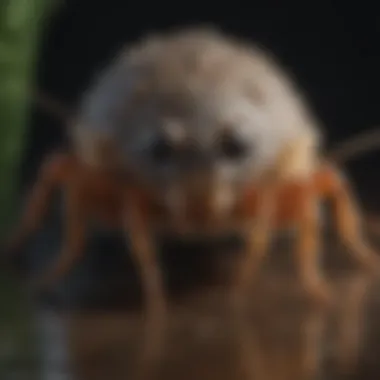

Local and National Regulations
Pest control regulations can vary significantly between local and national levels. Local regulations often focus on specific pests prevalent in the area, as well as the methods that are considered environmentally safe. These rules may include:
- Licensing Requirements: Pest control companies must often be licensed by local authorities to operate. This ensures they are trained and knowledgeable about local pest issues.
- Specific Product Usage: Certain pesticides may be restricted or banned in particular regions, contributing to safety and protection of local wildlife and ecosystems.
- Reporting and Inspections: Local authorities may require pest control companies to report usage of hazardous materials and undergo periodic inspections.
On a national level, agencies like the Environmental Protection Agency (EPA) set standards for pest control practices throughout the United States. The EPA regulates the sale and use of pesticides and ensures they are used in a manner that poses minimal risk to public health and the environment.
Compliance Challenges
Even with clear regulations in place, compliance can be challenging for pest control companies. A few key difficulties include:
- Keeping Updated: Regulations can change frequently, and it can be hard for pest control companies to stay current with these updates. This can lead to inadvertent non-compliance, exposing companies to potential fines and penalties.
- Training Requirements: Employees must be trained regularly on the newest regulations and methods. This may involve time and resource investment, which can be daunting for smaller companies.
- Client Education: Often, homeowners might not understand the need for compliance. Educating clients about why Larue Pest Control follows specific regulations can be a challenge yet is critical for mutual understanding and trust.
Case Studies and Success Stories
Case studies and success stories serve as vital components in understanding the practical applications of pest control strategies. They provide real-world examples of how Larue Pest Control effectively addresses pest issues for both residential and commercial clients. This insight is essential, as it allows potential customers and industry peers to evaluate the efficacy of various approaches utilized by the company. Furthermore, such stories showcase effective problem-solving as well as adaptive strategies tailored to specific situations, highlighting the expertise of Larue Pest Control. The examination of these case studies ultimately enhances the credibility of their claims and demonstrates their commitment to achieving successful pest management outcomes.
Residential Pest Control
In the realm of residential pest control, Larue Pest Control has successfully implemented a range of strategies to combat common household pests. One noteworthy case involved a family in a suburban area experiencing a significant infestation of ants. The situation was challenging due to the ants' nesting habits and quick reproduction rate.
Larue initially conducted a detailed inspection to determine the species of ants involved, assessing their entry points and nesting locations. The team employed a combination of baits and barrier treatments, ensuring comprehensive coverage. Within two weeks, the family noticed a marked decrease in ant activity. This success not only restored the family's peace but also highlighted Larue's ability to tailor solutions to the unique environments of their clients.
Such residential case studies demonstrate that Larue Pest Control prioritizes thorough assessments and effective interventions. Clients benefit from a personalized approach that emphasizes prevention alongside treatment, ultimately leading to a pest-free home.
Commercial Pest Management
When it comes to commercial pest management, Larue Pest Control has effectively partnered with various businesses, addressing both immediate concerns and long-term strategies. One successful story involved a local restaurant that faced recurring rodent issues. Such problems can severely impact operations, not only damaging reputation but also risking health code violations.
In this case, Larue implemented a multi-faceted strategy. They began with a comprehensive inspection to identify problem areas, such as potential entry points and food storage practices. Following this, they worked closely with the restaurant staff to develop training programs focusing on best practices for sanitation and food storage. The pest control team used both exclusion techniques and traps to manage the rodent population, ensuring no further entry or activity.
Within months, the restaurant reported a significant reduction in rodent sightings, and by actively involving staff in the solution, the restaurant has since maintained a pest-free environment. This success story underscores the importance of collaboration between Larue Pest Control and businesses, highlighting their dedication to achieving sustainable pest management solutions for commercial entities.
These case studies show that tailored solutions and a commitment to preventive measures are key to effective pest control.
Through these narratives, it becomes clear that Larue Pest Control not only resolves present challenges but also empowers their clients with knowledge and strategies to prevent future infestations.
Future Trends in Pest Control
The future of pest control is shaped by several dynamic factors. Understanding these trends is vital for homeowners. As technology and consumer expectations evolve, pest management solutions must adapt. This section will delve into emerging technologies and shifts in consumer preferences, highlighting their significance in pest control now and in the future.
Emerging Technologies
Recent advancements in technology have transformed how pest management companies operate. Smart pest control systems are leading the charge. These systems use sensors and automated alerts to monitor pest activity closely. This real-time data allows for quicker responses to infestations. Digital monitoring can prevent small issues from becoming serious ones. It ensures that treatments are applied precisely where needed, reducing wasted resources.
Moreover, drone technology is becoming applicable in pest control. Drones can survey large areas quickly, identifying pest populations without extensive manual inspection. These tech-driven solutions are often less intrusive and more environmentally friendly.
Other emerging technologies like artificial intelligence help in decision-making. AI algorithms analyze data patterns from past infestations. This capability leads to more informed treatment strategies and better resource allocation.
"Adopting new technologies in pest control not only enhances effectiveness but also demonstrates a commitment to sustainability."
Shifts in Consumer Preferences
The preferences of consumers are shifting towards more eco-conscious solutions. Homeowners today are increasingly aware of their carbon footprint. They are looking for pest management that aligns with their values. Using chemical-free or low-toxicity products is now a priority for many clients.
Moreover, the demand for customized service has grown. Clients want solutions tailored to their specific needs rather than one-size-fits-all approaches. This trend urges pest control companies to be more flexible.
Lastly, the emphasis on preventative measures over reactive solutions is becoming notable. Homeowners prefer strategies that prevent pests from entering their homes in the first place, rather than dealing with an infestation after it occurs. This proactive approach fosters longer-term relationships between pest control providers and consumers.
In summary, the future of pest control is undoubtedly interconnected with technology and evolving consumer demands. Recognizing these trends allows both pest control professionals and homeowners to stay ahead of potential challenges.
End
The conclusion serves as a crucial element in any comprehensive exploration, succinctly synthesizing the key findings presented throughout the article. In this context, the discussion surrounding Larue Pest Control has highlighted several key aspects that illuminate the company's role within the pest management industry. Understanding these elements is essential for both homeowners and pest control professionals seeking effective solutions to pest issues.
Summary of Findings
Larue Pest Control exemplifies a balanced approach to pest management, emphasizing eco-friendly practices while maintaining effective methods. The findings in this article reveal that:
- Larue actively employs both traditional and innovative techniques, thus bridging the gap between established practices and modern advances in pest control.
- The integration of technology, such as digital monitoring systems, enhances service efficiency and effectiveness.
- There is a growing emphasis on sustainable practices, driven by an understanding of the environmental impact of pest control.
- Customer engagement is prioritized, ensuring that clients are well-informed and supported before, during, and after services are rendered.
These findings collectively demonstrate that Larue Pest Control is not just a service provider but a thought leader in promoting sustainable pest management.
Recommendations for Homeowners
For homeowners looking to tackle pest problems effectively, several recommendations can be derived from this exploration:
- Identify Pests Clearly: Understanding what type of pest infestation is present is crucial. Consult with professionals to get a thorough identification and evaluation of the situation.
- Consider Eco-Friendly Options: When selecting pest control services, prioritize providers like Larue that emphasize eco-friendly practices. This ensures safety for your family and pets while protecting the environment.
- Engage with the Service Provider: Take advantage of consultation services to understand the pest management plan. Good communication with your pest control provider can lead to better outcomes.
- Follow Up After Services: Post-service support is key. Follow any recommendations provided by the pest control professionals, and maintain open communication about any lingering issues.
- Be Informed: Stay updated on pest control trends and technologies. Knowledge of emerging methods can empower homeowners to make informed decisions about pest management.
In summary, the importance of concluding discussions like these lies not just in recapping what has been explored but also in providing actionable insights to our audience. Adopting the strategies discussed will help in making well-informed pest management decisions.












